Featured image credit: Matthew Dillon
Just two hours south of Palm Springs, you’ll find a desert preserve where history loses all meaning while resonating with unusual profundity. Grizzled prospectors eternally sift through the running waters of imagined streams, prehistoric sloths lumber across arid sands, and mythical serpents swim beneath rivers of asphalt. If it sounds like magic, it may be. But it’s a magic you can touch, forged from hot metal saturated with a color at once rusty and romantic. It’s a sprawling desert wonderland known as Galleta Meadows, bringing additional life to Anza Borrego State Park. Defying reason and reality itself, it still most certainly exists.
Dennis Avery’s Dream for Anza Borrego State Park
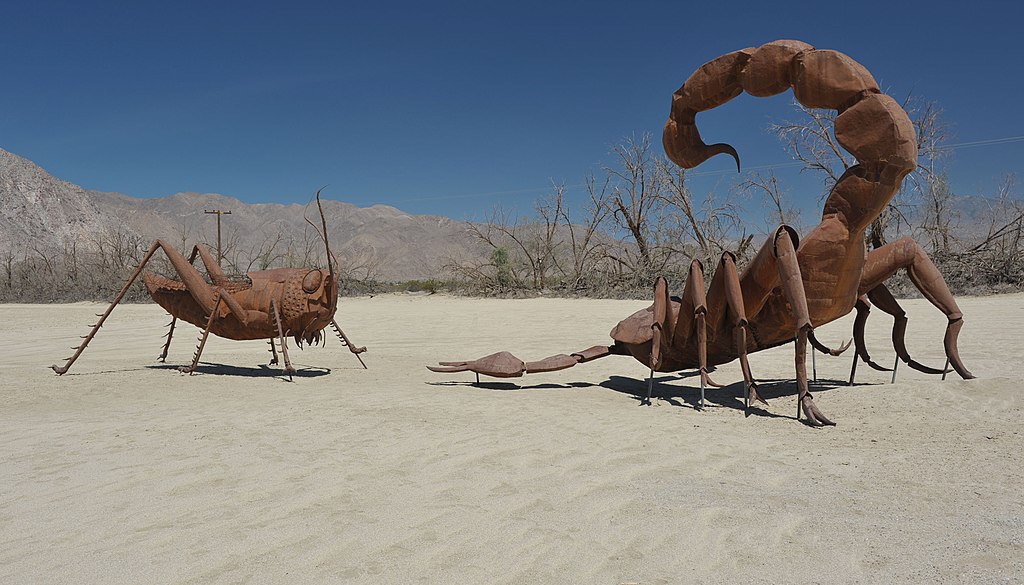
The late Dennis Avery, former heir to the Avery Labels fortune, harbored a creativity that betrayed his office supply foundation. He owned a series of consecutive plots of land near Borrego Springs, a tiny village situated along a stretch of Southern California’s S-3 highway. Look in any direction from Borrego Springs and you’ll see nothing but the wide open desert preserves of Anza Borrego, the largest state park in California. Well, almost wide open. There are elephants. And dinosaurs. And a dragon.
While Avery purchased the land with conservation in mind, his imagination soon began to populate it with rust-colored guardians; a boundless gallery of terra-bound titans. For those of us without means, it may have just been a passing fancy. But for Avery, who, again, was sitting upon a vast family fortune, it may as well have been a prophecy.
Ricardo Breceda’s Steel Menagerie
Of course, all the money in California is nothing without skill. Enter Ricardo Breceda, a former construction worker from Perris, California by way of Durango, Mexico. After a debilitating injury, his life (and career) took a dramatic turn, to say the least.
Breceda isn’t a man who easily acknowledges limitations. When his six-year-old daughter innocently requested a dinosaur for Christmas, Breceda did what any good parent only wishes they could. He gave her a dinosaur. It didn’t eat much, nor did it make a very big mess. After all, the looming 20-foot tall tyrannosaurus rex was crafted from steel. But, not to diminish Breceda’s accomplishments, it’s worth noting he did have to teach himself welding to scratch that particular gift off the Christmas list.
Breceda’s obsession with crafting intricately detailed steel sculptures was only just beginning. With a sense of compulsion any artist would recognize, he immersed himself in spindly wires and thick reinforcement beams. Aided by fire, he used an arsenal of screwdrivers and hammers to tighten, bend, and beat his art into stunning existence.
After crafting his steel menagerie of prehistoric pets, Breceda’s collection earned the attention of gawking passersby along I-215 in Perris, California and a fitting (if not exactly catchy) nickname: Perris Jurassic Park. And then Dennis Avery came calling.
Ready, Set, Go… mphothere
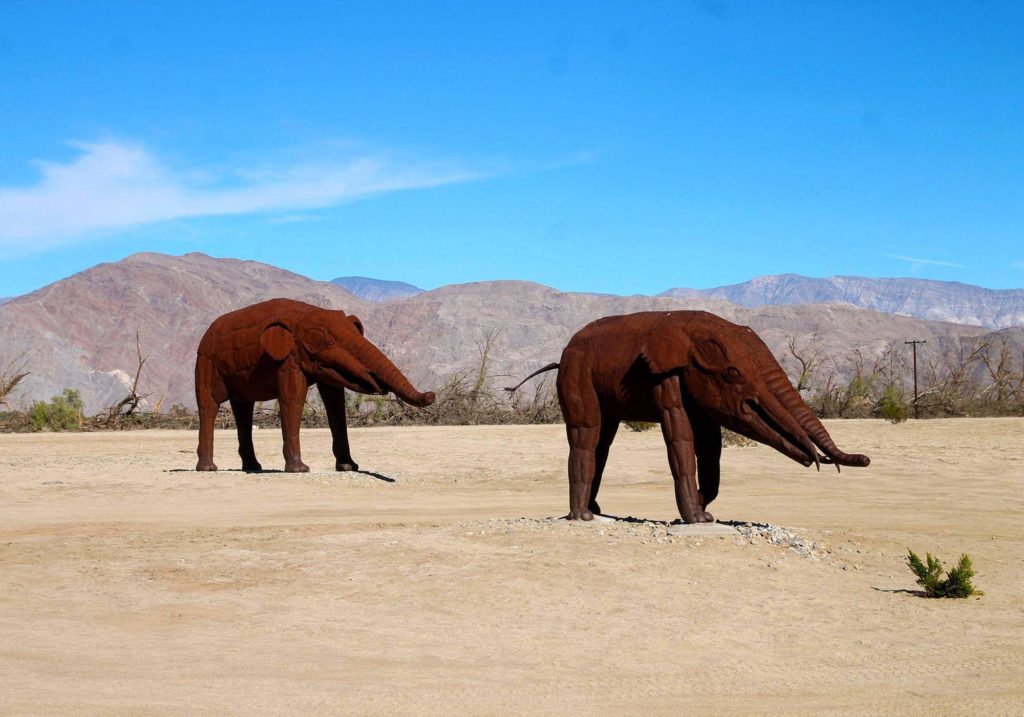
If you visit Galleta Meadows today, you’ll find the sprawling desertscapes populated with over 130 of Breceda’s ruddy steel sculptures stretched over a 22 mile round trip. Yet, in 2008, shortly after Avery first met with Breceda to commission the seemingly endless project, there were just two sculptures.
The first to be installed explored Breceda’s and Avery’s shared interest in California’s prehistory. Around 4 million years ago, during the Pliocene period, an ancient ancestor of the elephant roamed the land that would one day be California. Known as the gomphothere, the prehistoric pachyderm had certain differences that distinguished it from modern day elephant species.
Making it the subject of his first two sculptures, Breceda captured the downward swooping tusks and the elongated bottom jaws associated with primitive gomphotheres. The duo not only heralded the sculptures to come, but also emphasized the artist’s astounding attention to detail with their segmented trunks, muscle definition, and expressive lidded eyes.
The Themes Explored in Galleta Meadows
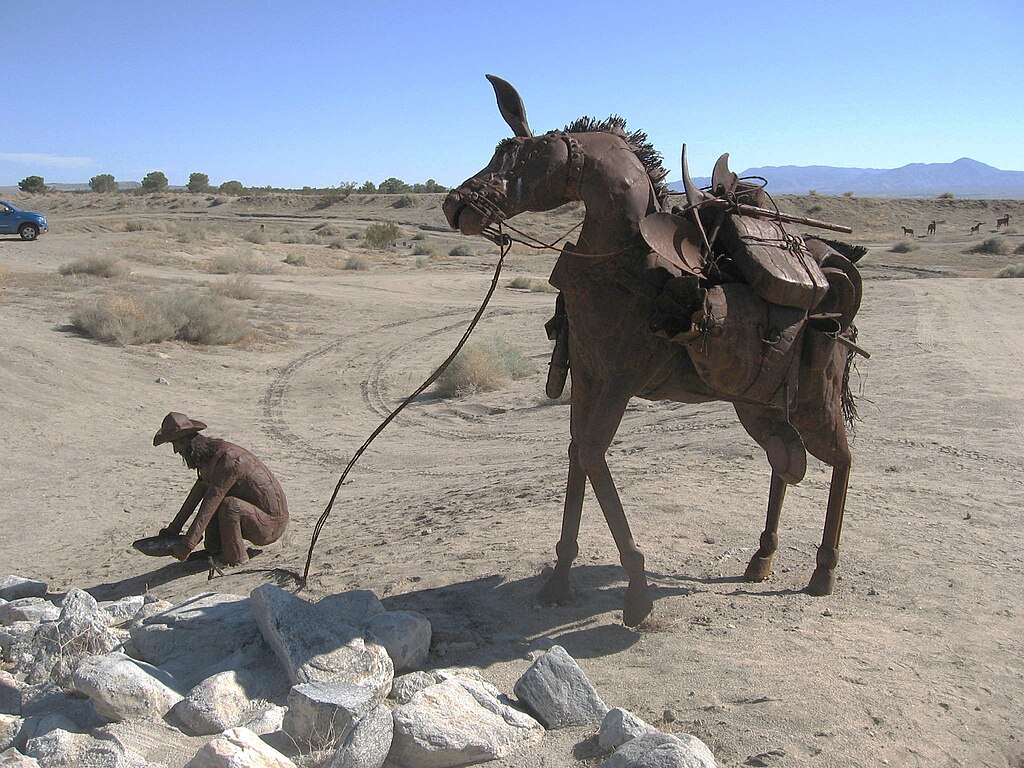
Breceda’s works for Galleta Meadows seem to fall into four distinct categories. There’s the prehistoric, possibly the most prevalent. It’s worth noting that every dinosaur and prehistoric mammal in the Galleta Meadows menagerie is inspired by fossils found at nearby dig sites; some of the richest grounds for paleontological finds in the country.
Then there are the sculptures commemorating the history of the Anza Borrego area; the people and events that shaped its culture. These pieces almost seem celebratory in nature and provide stationary vignettes of desert life over the centuries.
A third theme finds Breceda exploring the natural world of Anza Borrego State Park with steel interpretations of the region’s flora and fauna. And finally, there’s at least one instance in which Breceda delves into pure fantasy in the most decadent of ways.
Invoking the Elements for Sky Art
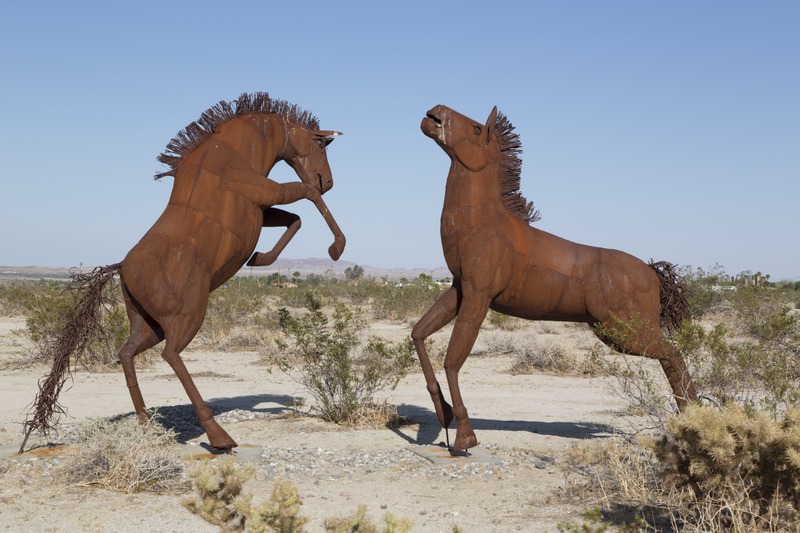
Avery described Breceda’s instantly recognizable sculptures as “Sky Art”. It’s an interesting term for tangible earthbound creations crafted from materials harvested from the ground. Yet, like the Magician in the tarot pantheon, the artist seems to access every element in the process. Fire unlocks the form, melting the metal into malleability. Yet, perhaps the sculptures’ true liquid parallel is in their sense of fluid motion, remarkable in static structures.
So, where does the sky come into it? Avery is no longer around to confirm, so we can only posit that the sky serves as the canvas, contrasting against the intricate statues. Each piece is a looming creation, looking particularly bold against the interminable blue skies above Galleta Meadows. Anza Borrego State Park is also an International Dark Sky Park, so shutterbugs can get some truly cosmic long-exposure night shots of Breceda’s creations.
Steel Sentinels of Galleta Meadows
The stories behind Breceda’s work aren’t always immediately obvious, but can be unearthed with a bit of digging. For example, a cross-toting robed missionary ornamented by stone prayer beads and accompanied by a jovial canine companion is meant to be Pedro Font. As the chaplain of an expedition from Catalonia, Spain to Alta California, Font recorded his account in With Anza to California.
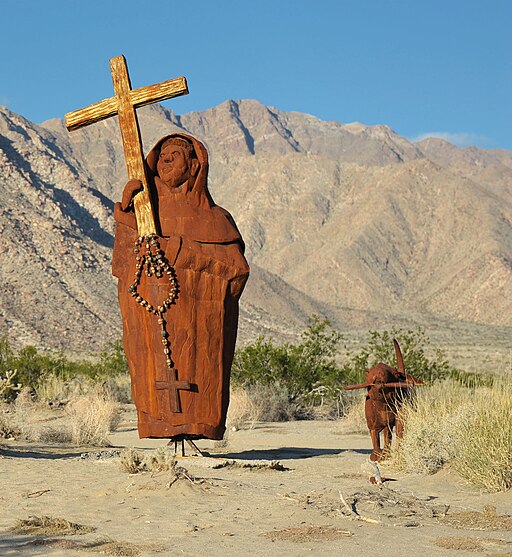
Others are more representative of themes that color the area’s history than spotlight a specific individual. A bust of a Native American distinguished by a golden head contrasting against skyward-stretching rust red feathers memorializes the roles that indigenous peoples played in expeditions through the California frontier. Another sculpture of a prospector eternally sifting while his pack mule watches on represents the gold rush. The area that would become Anza Borrego State Park was a hotspot in the early days of the gold miner influx.
Some of the sculptures even delve into more recent times. Take for example a piece depicting a rollicking 1946 Willys CJ-3A jeep climbing a pile of boulders. Breceda intended this as a nod to the off-roading that continues to make Galleta Meadows and Anza Borrego a popular travel destination.
Watch Out for the Sand Wyrm
But perhaps none of the Galleta Meadows sculptures is as well-known or beloved as the one that broke from convention. Breceda’s Chinese dragon is one of the more recent additions to the Anza Borrego menagerie. Spanning a jaw dropping 350-feet, the wyrm appears to wave through sand like water, diving on one side of the road and emerging on the other. Its bearded and frilled head is raised in a regal rage, mouth agape as it licks the sky with its forked tongue. Visitors are often mesmerized by the detail of this massive piece with each individual scale meticulously crafted by the artist.
Finding the Sculptures in Sprawling Galleta Meadows
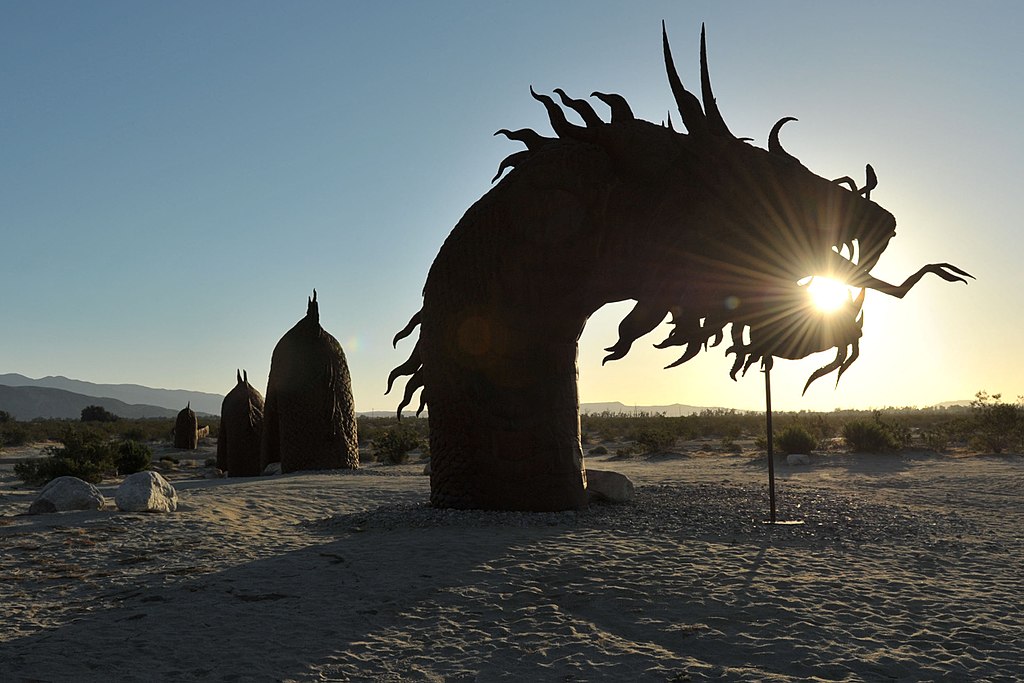
When you drive into Galleta Meadows, you won’t be able to miss the sculptures. However, finding all of the over 130 pieces can be a bit more of a challenge. You can use a digital map to get started, but for something a bit more comprehensive, visit nearby Borrego Springs. There you can find up-to-date laminated maps guiding you directly to all of the creations in Galleta Meadows. Breceda erected some of these statues a decent distance from the road, so a map is crucial for completists.
Since Avery’s passing, the Under the Sun Foundation has overseen
operation of Galleta Meadows. It’s still free and literally open to the
public, unrestrained by fences and the like despite remaining private
property. Breceda’s work on the attraction is allegedly complete. But
the artist has been known to introduce new sculptures to Galleta
Meadows, even after declaring his work finished. After all, is an
artist’s work ever truly done?
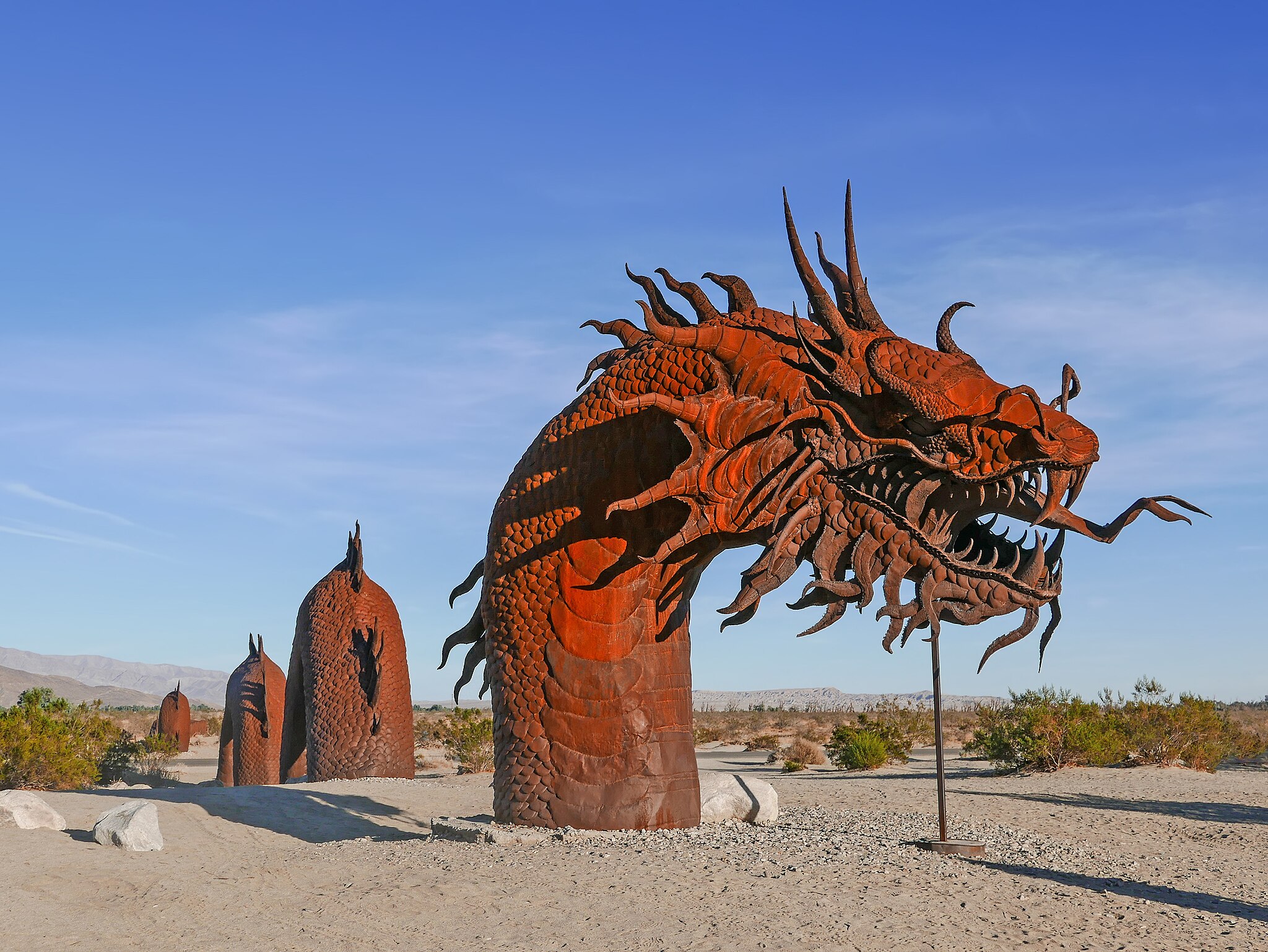
Comments
Post a Comment